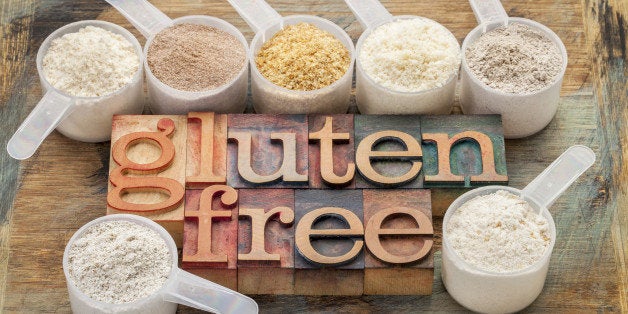
There are lots of good reasons to go grain-free. For instance, cutting wheat and other grains out of your diet can help you normalize your blood sugar, blood pressure, and cholesterol levels.
But I won't lie: Giving up grains is a big lifestyle change. And at first, it can be hard -- especially if you love baking.
So if you're hesitating to let go of grains entirely, I understand. But the good news is that you can still eat the foods you love! In fact, I think you'll be amazed at what you can make with grain-free flours.
The trick is to stop thinking that flour equals grains. There's a whole world of flours and thickeners that don't contain grains, and they're all delicious. Once you know how to use them, you'll be able to make just about any food you want - -from pancakes and waffles to crackers and breads. Here are some tips on how to use the most popular grain replacements.
Blanched Almond Flour
This flour, made from skinned almonds, is excellent for everything from muffins and quick breads to cookies, brownies, and graham crackers. In addition, you can make a killer pizza crust with it.
The fineness of almond flour's grind varies from brand to brand, and the finest grind will typically give you the best results. To keep your flour fresh, store it in the freezer--but make sure you bring it to room temperature before you bake with it, or it'll be "clumpy." You can try substituting it on a one-to-one basis for wheat flour in your recipes, but you'll get much better results with recipes specifically designed for almond flour.
In addition to baking with blanched almond flour, you can bread meats with it. (I use it to bind fritters, too.) Just watch carefully when you brown coated meats, because they can burn easily.
Almond flour
Almond flour is made from whole almonds. It's very different from blanched almond flour, so make sure you don't confuse the two. Regular almond flour is more heavy and "mealy" than blanched almond flour, so it's best to save it for breading, pie crusts, or cookie recipes that specifically call for it.
Other nut and seed flours
If you want to be adventurous (and you have a little extra cash) try substituting hazelnut or chestnut flour for almond flour. It'll give your baked goods a whole different nutty dimension.
And if you're allergic to nuts, try sunflower seed flour instead. There's just one thing to know ahead of time: Sunflower seeds contain chlorogenic acid, and if you mix sunflower seed flour with enough baking soda or baking powder, your baked goods may develop green speckles when they cool. This is totally harmless, but it does look strange!
Coconut flour
This is a great go-to flour for waffles, cookies, cakes, and muffins. I also use it to replace bread crumbs in recipes like meatballs and crab cakes. It's so versatile that it should definitely be a staple in any grain-free kitchen.
Coconut flour soaks up liquids like a sponge, so use it in recipes that contain a large amount of wet ingredients. You'll generally need one cup of liquid and several eggs for each cup of coconut flour you use. Sift the flour before you use it to remove any lumps--and let a batter made with coconut flour "rest" a bit before putting it in the oven, because it'll thicken up.
Cooking with coconut flour is an art, and tiny changes in your measurements can lead to big changes in your results. So I recommend sticking with simple recipes until you get the hang of it.
Arrowroot powder
Want to make gravy or thicken soups and sauces without using wheat flour or corn starch? Then this is your answer. However, don't use arrowroot powder with dairy products, because it'll turn slimy.
To thicken a sauce with arrowroot, mix it with an equal amount of cold water. Then whisk the mixture into a hot liquid for about half a minute. (Don't mix it directly into hot liquid, or it'll clump.) Avoid overheating sauces that contain arrowroot powder, because they'll break down.
You can replace flour with arrowroot powder on a one-to-one basis. If you're replacing cornstarch, use a little less.
You can also add arrowroot powder to baked goods containing almond flour or coconut flour. It acts a little like gluten, making them spongier and less crumbly.
Tapioca starch
Tapioca starch makes breads containing coconut or almond flour "bouncier" because it adds elasticity. You can also use it on its own to make terrific crepes, pancakes, and flatbreads.
Plantain flour and plantains
Plantain is another fun flour for crepes or pancakes, and some people use it to make tortillas. It has a distinctive taste that most people like. It's not easy to find this flour in stores, but you can order it online.
You can also use pureed green plantains in baking. Plantains aren't bananas--but they look like them, and you'll find them in the banana section of your store's produce department. The greener they are, the better, because they'll taste more neutral and less "banana-ish."
Be ready for some trial-and-error
Baking with grain-free flours and thickeners takes practice, so start your new adventure with the right attitude. You may have a few flops, but pretty soon you'll find that it's just as easy as baking with grain-based flours. You'll also discover that the Internet is loaded with grain-free baking recipes.
So experiment... and have fun. Start with simple recipes, like crepes and crackers and cookies, and work your way up to tortes and soufflés (yes--soufflés!). As you master each new ingredient, try another one. Before long, you'll be a pro--and you'll never miss grain-based flours again.